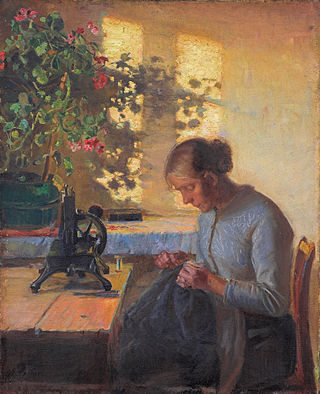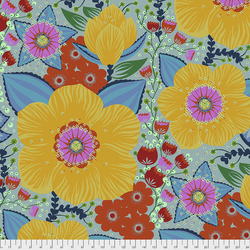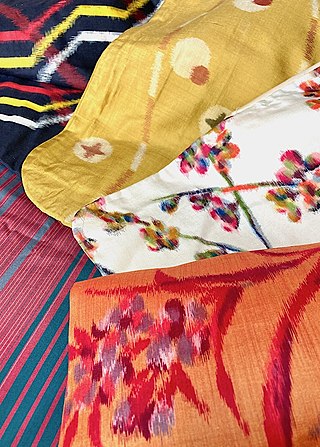Related Research Articles

The kimono is a traditional Japanese garment and the national dress of Japan. The kimono is a wrapped-front garment with square sleeves and a rectangular body, and is worn left side wrapped over right, unless the wearer is deceased. The kimono is traditionally worn with a broad sash, called an obi, and is commonly worn with accessories such as zōri sandals and tabi socks.

Sewing is the craft of fastening or attaching objects using stitches made with a sewing needle and thread. Sewing is one of the oldest of the textile arts, arising in the Paleolithic era. Before the invention of spinning yarn or weaving fabric, archaeologists believe Stone Age people across Europe and Asia sewed fur and leather clothing using bone, antler or ivory sewing-needles and "thread" made of various animal body parts including sinew, catgut, and veins.

There are typically two types of clothing worn in Japan: traditional clothing known as Japanese clothing, including the national dress of Japan, the kimono, and Western clothing, which encompasses all else not recognised as either national dress or the dress of another country.
Hakama are a type of traditional Japanese clothing. Originally stemming from Ku pinyin: Kù, the trousers worn by members of the Chinese imperial court in the Sui and Tang dynasties, this style was adopted by the Japanese in the form of hakama in the 6th century. Hakama are tied at the waist and fall approximately to the ankles. They are worn over a kimono specially adapted for wearing hakama, known as a hakamashita.

Clothkits is an English clothing and craft company, based in Chichester, West Sussex who sell kit clothing, dressmaking kits, haberdashery, sewing machines and all manner of other sewing supplies. In addition to this bricks and mortar retail outlet, the company have a large online business, and teach dressmaking classes from their contemporary sewing studio.

Fashion design is the art of applying design, aesthetics, clothing construction and natural beauty to clothing and its accessories. It is influenced by culture and different trends and has varied over time and place. "A fashion designer creates clothing, including dresses, suits, pants, and skirts, and accessories like shoes and handbags, for consumers. He or she can specialize in clothing, accessory, or jewelry design, or may work in more than one of these areas."

In sewing and tailoring, a lining is an inner layer of fabric, fur, or other material inserted into clothing, hats, luggage, curtains, handbags and similar items.
Isabel Marant is a French fashion designer, owner of the eponymous fashion brand. She won the Award de la Mode (1997), the Whirlpool Award for best female designer (1998), Fashion Designer of the Year at British Glamour's Women of the Year Awards (2012). She was named Contemporary Designer of the Year at the Elle Style Awards in 2014. Her collaboration with H&M in 2013 was so successful that company's website crashed under the demand and the collection was sold out within 45 minutes. Celebrities wearing Marant's designs include Alexa Chung, Katie Holmes, Victoria Beckham, Kate Moss, Sienna Miller, Kate Bosworth, and Rachel Weisz.
Natalie "Alabama" Chanin is an American fashion designer from Florence, Alabama. From 1976 until its closure in 2005, Tee-Jays Manufacturing was one of the largest employers in the Florence textile industry. Chanin's business now operates as a clothing manufacturer on the grounds of the former Tee-Jays company and is now a part of the zero-waste fashion movement. Her design company uses organic cotton fabric in their designs. Chanin's "open source" philosophy means that patterns and techniques for some of her garments are openly available through books and workshops.
Janet Arnold was a British clothing historian, costume designer, teacher, conservator, and author. She is best known for her series of works called Patterns of Fashion, which included accurate scale sewing patterns, used by museums and theatres alike. She went on to write A Handbook of Costume, a book on the primary sources on costume study, and Queen Elizabeth's Wardrobe Unlock'd, as well as many other books.

Kimono that carried designs depicting scenes from contemporary life became popular in the Empire of Japan between 1900 and 1945, during Japan's involvement in WWII. Now referred to as omoshirogara, the decoration of many kimono produced during this time often depicted the military and political actions of Japan during its involvement in the war on the side of the Axis powers. In English, these kimono are commonly referred to as 'propaganda kimono'. Traditional items of clothing that were not kimono, such as nagajuban (underkimono), haori and haura also featured wartime omoshirogara, as did miyamari, the kimono worn by infants when taken to a Shinto shrine to be blessed. Omoshirogara garments were typically worn inside the home or at private parties, during which the host would show them off to small groups of family or friends, and were worn by men, women and children.

The Khalili Collection of Kimono is a private collection of more than 450 Japanese kimono assembled by the British scholar, collector and philanthropist Nasser D. Khalili. It is one of eight collections assembled, published and exhibited by Khalili, each of which is considered to be among the most important collections within their respective fields.

Anna Maria Horner is an artist, author and fabric designer in Nashville, Tennessee, known for her colorful fabric designs, quilts, and sewing patterns. In addition to teaching classes and selling items globally under her namesake brand, she has written several books about sewing, quilting, and needlework. Horner has appeared on The Martha Stewart Show and been featured in Better Homes and Gardens. In May 2015 she opened Craft South, a craft store and studio in Nashville.
Bernadette Banner is an American YouTuber and author currently based in London.

Japanese clothing during the Meiji period (1867–1912) saw a marked change from the preceding Edo period (1603–1867), following the final years of the Tokugawa shogunate between 1853 and 1867, the Convention of Kanagawa in 1854 – which, led by Matthew C. Perry, forcibly opened Japanese ports to American vessels, thus ending Japan's centuries-long policy of isolation – and the Meiji Restoration in 1868, which saw the feudal shogunate dismantled in favour of a Western-style modern empire.

A tanmono is a bolt of traditional Japanese narrow-loomed cloth. It is used to make traditional Japanese clothes, textile room dividers, sails, and other traditional cloth items.

Monpe otherwise called moppe or mompei, and in Korean, ilbaji, is an umbrella term used for the traditional style of loose agricultural work-trouser in Japan. It is most commonly worn by female labourers, especially farm workers in agricultural and mountain villages. A traditional pair of monpe is recognised by having a loose waistband and a drawstring hem around each ankle. The garment is historically thought to have descended from the traditional court trousers, Hakama because of the loose shape of the trouser leg and how the piece of clothing is designed to also be worn over kimono. This style is sometimes referred to as yamabakama or nobakama.

Hifu is a kind of jacket traditionally worn over a kimono. Towards the end of the Edo Period (1603–1867), it was worn by men in cultural positions, such as by chajin and haijin. It later came to be worn by women. Sodenashi hifu are sleeveless and more likely to be worn by children, while sleeved hifu are more often worn by adults. Sleeveless hifu serve as smocks, protecting the clothing underneath, while sleeved hifu are more likely to be worn for warmth. Sleeveless hifu are commonly seen as part of a child's clothing when worn for Shichi-Go-San.

Meisen is a type of silk fabric traditionally produced in Japan; it is durable, hard-faced, and somewhat stiff, with a slight sheen, and slubbiness is deliberately emphasised. Meisen was first produced in the late 19th century, and became widely popular during the 1920s and 30s, when it was mass-produced and ready-to-wear kimono began to be sold in Japan. Meisen is commonly dyed using kasuri techniques, and features what were then overtly modern, non-traditional designs and colours. Meisen remained popular through to the 1950s.
References
- 1 2 3 4 5 Stively, Meg (December 2018). "Inside the Wiksten Studio". Seamwork Magazine. Retrieved January 24, 2020.
- 1 2 McCray, Linzee Kull (2013). "Artist profile: Jenny Gordy of Wiksten". Interweave Stitch with Style: 16–18.
- 1 2 "One to Watch: Wiksten". NBC New York. May 24, 2011. Retrieved January 24, 2020.
- 1 2 Causey, Jennifer (2014). Brooklyn makers : food, design, craft, and other scenes from the tactile life. Princeton Architectural Press. ISBN 9781616893071 . Retrieved January 24, 2020.
- 1 2 "About us". Wiksten. Retrieved January 24, 2020.
- ↑ Wilson, Nicholas. "Studio Visit: Jenny Gordy of Wiksten on Constructing a More Inclusive Approach to Style". The Style Line. Retrieved January 24, 2020.
- ↑ "Updated Wiksten Kimono". shoplamercerie.com. La Mercerie. September 4, 2018. Retrieved January 24, 2020.
- ↑ "Learning and Unlearning: an interview with Emi Ito on cultural appropriation". Pom Pom Quarterly. May 31, 2019. Retrieved January 24, 2020.
- ↑ "Kimono Jacket Name Change". Wiksten. 2018. Retrieved January 24, 2020.
- ↑ Goddard, Joanna (August 22, 2017). "A Week of Outfits: Jenny Gordy". A Cup of Jo. Retrieved January 24, 2020.
- ↑ Gillespie, Dacy (August 10, 2017). "creative motherhood: jenny gordy". mindful closet. Retrieved January 24, 2020.
- ↑ "Instagram". www.instagram.com. Retrieved December 15, 2024.
- ↑ Gordy, Jenny (December 15, 2024). "Shop Wiksten".
{{cite web}}: CS1 maint: url-status (link)